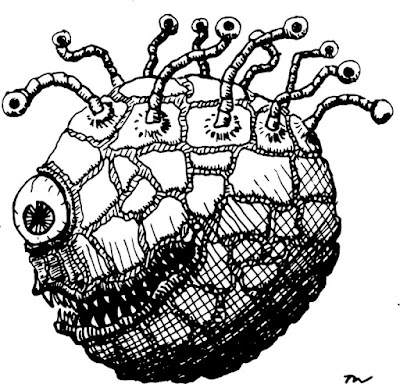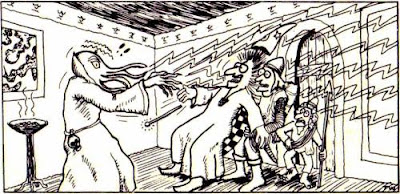The first few years of the Old School Renaissance were marked by a renewed appreciation not just of
early roleplaying games but also of the
pulp fantasy stories that inspired them. This was the time when Appendix N of Gary Gygax's
AD&D Dungeon Masters Guide became a frequent topic of discussion on blogs and forums, much to the satisfaction of those of us who felt a strong injection of sword-and-sorcery was the perfect antidote to what we felt was an increasingly video-gamified hobby (remember: this coincided with the release of
D&D Fourth Edition) that had lost sight of its literary roots.
This is the backdrop against which many of the earliest D&D retro-clones – emulations of earlier editions – appeared, including Lamentations of the Flame Princess. Calling itself a "weird fantasy role-playing game," LotFP took seriously the goal of bringing more pulp fantasy-inspired content into fantasy gaming, especially in its adventures, which quickly gained a reputation for being, by turns, imaginative, grotesque, challenging, deadly, and prurient – among many other extravagant adjectives.
However, as LotFP's creator, James Raggi, found his strange Muse, its adventures moved away from generic pulp fantasy scenarios of the sort one might have found in Weird Tales during the Golden Age of the pulps and toward a weirder, even more brutal version of Earth's 17th century. This new focus on historical fantasy helped LotFP distinguish itself from its fellow retro-clones, but it also, I think, narrowed its appeal somewhat, since most fantasy gamers, old school or otherwise, are looking for adventures they can easily drop into campaign settings other than Earth during the 1600s.
While I am a big fan of
LotFP's pivot to historical fantasy, I miss the ahistorical strangeness of stuff like
Death Frost Doom,
Hammers of the God, or
The Monolith from Beyond Space and Time. Consequently, when I learned about D.M. Ritzlin's
The Lair of the Brain Eaters, I was intrigued. Unlike most recent
LotFP releases, this adventure didn't seem to be set in the 17th century. Rather, it seemed more like something from Robert E. Howard's Hyborian Age or perhaps Clark Ashton Smith's Hyperborea – a lurid, necromantic pulp fantasy scenario of the kind we haven't seen for
LotFP in a while.
That should come as no surprise. Ritzlin is the proprietor of
DMR Books, a small press dedicated "fantasy, horror, and adventure fiction in the traditions Robert E. Howard, H.P. Lovecraft, and other classic writers of the pulp era." Indeed,
The Lair of the Brain Eaters shares its title with a short story Ritzlin wrote for the collection,
Necromancy in Nilztiria. According to the author, some of the story's details have been changed (and "a great many more have been added"), so this adventure is less
directly adapted and more
inspired by its source. Even so, it's quite unusual by the standards of contemporary
Lamentations of the Flame Princess.
The adventure concerns a cult dedicated to the consumption of human brains. Called the Yoinog – supposedly an ancient term meaning "knowledge seekers" – the cult serves the necromancer Obb Nyreb, furnishing him with a fresh supply of corpses as he attempts to unravel the mysteries of Veshakul-a, the goddess of death. Nyreb and the Yoinog have established themselves in a network of caves beneath a graveyard of the city of Desazu. Unfortunately, in their zeal for graverobbing, the cult has drawn attention to their master's activities, thereby providing an opening for the player characters to involve themselves in the adventure.
The Lair of the Brain Eaters is short and to the point. The cult's cave network consists of only twenty keyed areas, with Nyreb's chambers occupying an additional nine. Most of them are described briefly, with little in the way of extraneous detail. Do not, however, mistake its comparatively spartan descriptions for a sparseness of ideas – quite the contrary. The florid prose of many adventures is often chalked up to the designer's desire to be a writer of fiction. Here, the opposite is the case: the text's concision signals that its designer is already a skilled fictioneer and understands well that less can be more.
For example, this is part of the description of a "bottomless pit": "This pit is not really bottomless, but it amused Obb Nyreb to tell the Yoinog it was, and they never doubt him." Elsewhere, a kitchen is described thusly: "Grimy pots, pans, and plates litter the floor. A cauldron large enough to contain a man sits in the center of the room, while smaller ones dangle from the ceiling." Speaking as someone whose personal style tends toward the aureate, I admire Ritzlin's ability to convey description, vital information, and mood through so few words. This approach also makes the descriptions easy to use at a glance, which is very helpful in play.
Designed for character levels 1–3, The Lair of the Brain Eaters is challenging. There are a lot of Yoinog within the caves, as well as other creatures, such as the apelike Skullfaces and mutant rats (some of which breathe fire – yes, it's a bit silly, but so what?). Fortunately, the caves contain lots of opportunities for the characters to act stealthily or otherwise use the environment to their advantage. In addition, there's a captive within who, if freed, can aid the characters in navigating the place. These factors, combined with some clever tricks and obstacles, creates a memorable locale for both exploration and combat.
The Lair of the Brain Eaters is an inventive, evocative, and unpretentious "meat and potatoes" adventure that I'd like to see more of – from
Lamentations of the Flame Princess or any other publisher. I think it'd be an especially great fit for anyone playing North Wind's
Hyperborea RPG, but it'd work just as well with any other fantasy game that draws inspiration from the pulps. I really enjoyed this one.
 Over the years, I've made occasional posts in which I've shared an image from The Official Advanced Dungeons & Dragons Coloring Album, but I've never written a full Retrospective post about this curious – and amazing – product. Today, I intend to correct that oversight.
Over the years, I've made occasional posts in which I've shared an image from The Official Advanced Dungeons & Dragons Coloring Album, but I've never written a full Retrospective post about this curious – and amazing – product. Today, I intend to correct that oversight.

















































